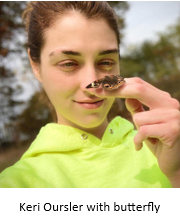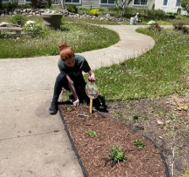Greencroft Communities Stories
Bringing Nature to Hamilton Grove Residents
By Keri Oursler, Brenda Phillips, and, in memory of Indiana Master Naturalist Pat Higgins
St. Joseph County Indiana Master Naturalists Keri Oursler, Pat Higgins, and Brenda Phillips partnered with Hamilton Grove Assisted Living to create a bird and pollinator habitat for residents. With dozens of feeders up since fall 2023, the residents now enjoy a steady stream of avian visitors to their windows, gardens, and porches. The Master Naturalists also established several native plant gardens designed to promote sustainable growth as the community faces climate change. Along with a raised bed garden, residents enjoy sitting and working outside while identifying birds and growing vegetables.
On Feb. 16, Brenda, Keri and Pat partnered with Hamilton Grove staff Melissa Taghon and Liz West to join the Great Backyard Bird Count organized by the Cornell Lab of Ornithology and National Audubon Society. The Great Backyard Bird Count, or GBBC, is an annual volunteer citizen-based science project that brings thousands of birders from all over the world to observe their backyard birds and record their sightings. This helps the Cornell Lab and Audubon scientists better understand global bird populations before one of their annual migratory periods. On this day, residents gathered in wheelchairs and assistive devices to identify and count nearly 20 different bird visitors to their feeders and reported their observations via e-Bird. After nearly an hour of steady observations, residents were excited to spot a Downy Woodpecker. A few months later, in spring, he was joined by a female, and residents are now hoping for the pair's babies to visit their feeders soon. |
... and many more to come, as more native plant beds get installed in the courtyard. Because Hamilton Grove communities also include stand-alone homes, independent-living residents are now helping fill feeders and support native plantings.
Since last fall, more diverse birds have arrived, including visitors not previously seen in the courtyard, such as Blue Jays, Hairy Woodpeckers, Rose-Breasted Grosbeaks, and Mourning Doves. While the food was a great help to the birds throughout the winter, the IMN team knew that fleshing out the courtyard and providing native plants would give these birds and many other types of wildlife a place to call "home." As a result of the team's efforts, the National Wildlife Federation recently certified the interior courtyard garden as wildscape-friendly to animals.
This project was made possible through volunteer efforts by IMNs, and with support from Wild Birds Unlimited. The low-cost effort has engaged residents who now ask excitedly about birds they not only see but also hear, and they are beginning to distinguish birdsong. Residents are becoming interested in the new gardens being installed and are seeing butterflies and bumblebees. We encourage anyone to reach out to similar facilities in their communities because this project has brought so many smiles to the residents who are now heading outside to enjoy what Indiana nature has to offer.
Source: IMNature newsletter |


 Along with the plants that attract hummingbirds, many native plants have been installed that will also attract butterflies, bees, moths, and a variety of native pollinators. One of the primary goals for the native plant beds is to create a habitat that can support a pollinator's full lifecycle. This includes not only planting a nectar source for the adult form, such as a butterfly, but also includes planting a food source for the larval form, such as a caterpillar. Another goal of the native plant beds is to make a natural food source for birds. With these goals in mind, these plants were added to the garden:
Along with the plants that attract hummingbirds, many native plants have been installed that will also attract butterflies, bees, moths, and a variety of native pollinators. One of the primary goals for the native plant beds is to create a habitat that can support a pollinator's full lifecycle. This includes not only planting a nectar source for the adult form, such as a butterfly, but also includes planting a food source for the larval form, such as a caterpillar. Another goal of the native plant beds is to make a natural food source for birds. With these goals in mind, these plants were added to the garden: